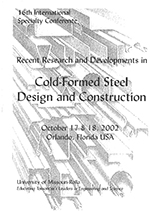Session Dates
17 Oct 2002
Abstract
Light-gage steel structures constituted mainly of cold-formed steel members have been widely employed in a variety metal construction in Brazil and many countries. The reduced thicknesses this elements making connection designing difficult due the occurrence of the local effects that generally govern these designs in thin elements. This paper presents and discusses the results of a experimental investigation of bolted connections in cold-formed angles (either equal or unequal legs) and channel members (1.55 to 3.75mm thickness), and an evaluation of the structural behavior of the connections with identification of the corresponding failure modes, with emphasis on the tensile capacity of angles and channels. The results are compared to those obtained based on the Supplement # 1 of the AISI/96 (1999) and Brazilian Code for the design of cold-formed steel structural members.
Department(s)
Civil, Architectural and Environmental Engineering
Research Center/Lab(s)
Wei-Wen Yu Center for Cold-Formed Steel Structures
Meeting Name
16th International Specialty Conference on Cold-Formed Steel Structures
Publisher
University of Missouri--Rolla
Document Version
Final Version
Rights
© 2002 University of Missouri--Rolla, All rights reserved.
Document Type
Article - Conference proceedings
File Type
text
Language
English
Recommended Citation
Maiola, Carlos Henrique; Malite, Maximiliano; Neto, Jorge Munaiar; and Goncalves, Roberto Martins, "Structural Behavior of Bolted Connections in Cold-formed Steel Members, Emphasizing the Shear Lag Effect" (2002). CCFSS Proceedings of International Specialty Conference on Cold-Formed Steel Structures (1971 - 2018). 8.
https://scholarsmine.mst.edu/isccss/16iccfss/16iccfss-session10/8
Structural Behavior of Bolted Connections in Cold-formed Steel Members, Emphasizing the Shear Lag Effect
Light-gage steel structures constituted mainly of cold-formed steel members have been widely employed in a variety metal construction in Brazil and many countries. The reduced thicknesses this elements making connection designing difficult due the occurrence of the local effects that generally govern these designs in thin elements. This paper presents and discusses the results of a experimental investigation of bolted connections in cold-formed angles (either equal or unequal legs) and channel members (1.55 to 3.75mm thickness), and an evaluation of the structural behavior of the connections with identification of the corresponding failure modes, with emphasis on the tensile capacity of angles and channels. The results are compared to those obtained based on the Supplement # 1 of the AISI/96 (1999) and Brazilian Code for the design of cold-formed steel structural members.



